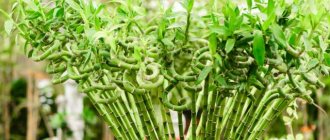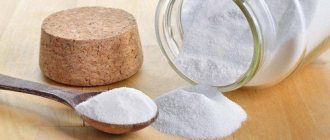Bamboo: Feng Shui meaning
The strong and unbending plant is characterized by its unpretentiousness and rapid growth. In Feng Shui, it symbolizes inner strength, resilience, wisdom, unbending will, health and longevity.
Bamboo in a pot
Other meanings of bamboo are lightness, peace, harmony. This is a plant that distributes energy flows in the right direction. It can protect you from evil spirits, protect your home from negativity, and help you fulfill your desires.
If you look closely, you will notice that each subsequent sector of bamboo is longer than the previous one. This symbolizes regular and gradual improvement in life.
Japanese interpretation of the symbolism of bamboo
The Japanese associate young bamboo shoots emerging from the ground with eternal youth and indomitable strength. It also brings with it truthfulness and devotion. The Japanese specially placed pieces of bamboo on the fire so that they would crack with sound and drive out evil spirits.
Flutes were also made from bamboo wood to summon good spirits. It was enough to carve the name of a good spirit on a pipe and play an improvised melody on it. For the Japanese, bamboo is the most powerful divine tree, strengthening the spiritual connection with nature. It is used to make amulets that protect its owner from natural disasters and bad incidents.
Number of bamboo stems
Living bamboo stems have a powerful positive effect. Placed in an apartment or office, they will not only decorate the room, but also gradually improve the life of the inhabitants. The number of stems in the house also has sacred significance:
- 2 - harmonize the relationship between a man and a woman, give love, mutual respect, fidelity;
- 3 - will attract happiness;
- 5 - will bring wealth, stable material wealth;
- 7 - give health, physical strength, vitality and longevity;
- 8 - continuous increase in well-being in all areas, because an inverted eight in Eastern philosophy means infinity;
- 9 - attract good luck;
- 20 - tied with a scarlet ribbon, they will restore the shaky relationships between family members, revive respect, friendship and love in the house;
- 21 - activates life-giving energy flows, which you can direct in the direction you need.
Expert opinion
Melnik Dmitry
feng shui master
Important! It is not recommended to put 4 stems in a vase, since in Feng Shui the number of four is associated with death. Such a composition made of bamboo will have a destructive effect on household members and will bring failures and misfortunes.
Pests and diseases of Dracaena Sander
The plant in question resists well all kinds of diseases and rarely suffers from pest attacks. Problems with lucky bamboo arise when it is grown in dirty water, as pests climb onto the plant from neighboring crops .
To destroy parasites (mealybugs, spider mites), plants are sprayed with insecticide solutions. If possible, plants are replaced with new ones.
Where to put bamboo at home?
The location of the noble plant in the house is of great importance. Bamboo indoors will help strengthen the desired sphere of existence if you place it in a certain area of the room.
A white vase with bamboo placed in the east will attract happiness. It is here that it is recommended to place 20 stems tied with a scarlet ribbon. This composition was called “Tower of Love”.
The southeastern zone is responsible for material well-being. If you lack money and wealth, place the plant in this place. Since the element of the southeast is water, it would be useful to place an image of a reservoir or a talisman representing water next to the bamboo.
A bamboo “bouquet” placed on the table in the center of the room will help improve your health. A plant placed in the southwest will attract love and strengthen family relationships.
How to twist bamboo?
Many people like the original curved shape of Sander's dracaena. How to twist bamboo yourself? Just place the young shoot of the plant in a curved tube!
This Lucky Bamboo will grow in a spiral. After being released “from captivity”, the curved shape of the stem will remain, but over time the shoot will produce new shoots and will continue to grow like an ordinary “erect” Sander dracaena.
Possible problems when growing happiness bamboo
- The leaves of the plant are too soft, have brown edges and look like someone has twisted them. This means that the room temperature is too low for bamboo.
- Brown spots on the leaves, brown edges or tips - the plant is not getting enough water. Or it “complains” about drafts.
- Dry light spots on the leaves - the plant has received sunburn due to too bright lighting.
- But if the lower leaves turn a little yellow, there is no need to worry - this is a normal natural process.
How does bamboo help in Feng Shui?
Living stems or bamboo products help the owner overcome all sorts of obstacles that come his way. As quickly as bamboo grows, success in all areas of life increases - work, study, material well-being.
Bamboo or products made from it will bring good luck. According to Feng Shui, the plant represents five elements at once:
- Tree (stems).
- Water (it is necessary for growing it).
- Earth (this is a ceramic vessel).
- Fire (scarlet ribbons that tie the stems).
- Metal (coins at the bottom of the vessel).
If all the elements are combined together, it will bring harmony to your life, increase wealth, attract love and restore health.
Bamboo as a gift
The Chinese believe so much in the power of this tree that every family has indoor bamboo.
There is a tradition of giving “lucky bamboo” to your friends on all holidays and celebrations, which is considered a true gift.
In this way, the Chinese provide a person with positive energy and wish him health and good luck. “Lucky bamboo” is given to both men and women because it is a symbol of yang, representing endurance, strength and courage.
Bamboo and products made from it are a universal feng shui symbol that can change your life for the better.
Bamboo care
The plant is unpretentious and ideal for beginning gardeners. To prevent bamboo from turning yellow, follow a few rules:
- Filtered or melt water is used to grow grass. It is changed weekly. Stagnation should not be allowed: according to Feng Shui, this is an unfavorable sign. It is important to ensure that the liquid level covers the roots by 1–2 cm, otherwise the shoots will rot.
- Bamboo does not like direct sunlight, so it is installed in different parts of the house. If the room is too dark, periodically move it to a lighted place.
- Yellowed bamboo shoots are removed with garden pruners, and the cut site is disinfected with wax. To do this, an ordinary candle is held over the fire, and the melted wax is collected in a tablespoon. It is enough to dip the top of the plant into it to protect it from drying out and developing infection.
- To feed bamboo, use a dracaena product or liquid for cut flowers. Both additives are sold in flower shops.
Bamboo in the interior of the house
Features of talisman placement
You can put bamboo in any area of your home, however, before you choose a direction, think about what is missing in your life? Are you expecting a promotion? Then place the bamboo in the western zone. Do you want your children to study well and easily find a common language with others? In this case, bamboo should be placed in the children's room.
It is advisable that the bamboo stand on a separate wooden table. If you want to attract good luck with the image of this plant, then hang the picture in the center of a blank wall. The painting should not be located near windows so that negative energy from external sources does not affect its effectiveness.
Bamboo products
In addition to the living plant, bamboo products are used to attract good luck. These are bamboo sticks, flutes, interior items or an image of the grass itself. They act as neutralizers of negative energy that is created in the apartment by protruding corners of cabinets, overhanging shelves, and sloping ceilings. Furniture elements with bamboo, made in oriental style, will be an effective addition to the interior.
Bamboo sticks
They have a cavity inside that traps negative currents and extinguishes them. The products are tied with red thread, since such an accessory enhances the properties of bamboo. Sticks suspended from the ceiling slow down the movement of qi energy, which is important if the layout of the rooms is unsuccessful. They can be placed near the window and front door, then negative flows will be neutralized.
Bamboo flute
As an element of protection, a bamboo flute is used, tied with a red thread and having scarlet tassels. It is hung on the wall at an angle of 30–45 degrees so that the short end points down and the long end points up. The talisman will neutralize “secret arrows” aimed at the owner, provide support, and drive away evil people.
For a flute to bring good luck, it is important to choose a solid product with protruding ribs. When purchasing, pay attention that the length of the sections gradually increases, the ribs should not be smoothed. Only such a product will become a talisman, drive away evil spirits, and give peace and happiness.
Expert opinion
Melnik Dmitry
feng shui master
It is important to handle the instrument with care, not to touch it unnecessarily, and not to play on it. Otherwise, the flute will lose its inherent energetic power.
Wind chimes
Bamboo wind chimes (or windmills) create vibration as air moves. They redirect energy, filter out the negative and let the beneficial part through. It is better to place them in the southern or southeastern part of the home on the air flow. When the bells touch, a gentle sound appears.
You can hang a bamboo mill between the front door and the stairs; this will help curb the rapid flow of energy. If the bells are placed between two doors opposite each other, this will prevent energy leakage.
When purchasing a living plant, do not forget to care for it. After all, only healthy and powerful bamboo will give happiness, prosperity, love and success in all areas.
Tree of Happiness
In China, bamboo is called the tree of happiness - this plant brings good luck, wealth and material well-being. Bamboo has very strong energy, so even the image of this plant or embroidery on fabrics attracts positive energy and promotes the circulation of Qi. Bamboo will bring good luck no matter what zone you place it in. The main thing is not to place the plant in a corner - an area where negative energy accumulates, which will affect the energy field of the talisman.
When placing bamboo or hanging an image, make sure that no sharp corners are directed at it - arrows of negative energy will greatly affect the effectiveness of the talisman. Bamboo will still decorate your home, but will lose its energetic power. In order to strengthen the bamboo, use red ribbons - they can be tied directly to the plant or tied around a picture with a talisman on it. Note! There should only be one bandage on each plant! Red attracts yang currents, which enhance the effects of bamboo.
You can strengthen bamboo with glass or crystal. Hang glass balls next to the plant or place a figurine, for example, of an elephant raising its trunk upward. Bamboo is part of the nature aspect, so it is highly desirable for the talisman to grow in a wooden pot. And of course, keep an eye on cleanliness - manifestations of chaos, such as dust, pollution and unnecessary objects, will negatively affect the energy of the talisman.
All stems can be united with a thin red thread. This thread will become a connecting link between plants and will accumulate Yang energy. Thanks to the accumulation of movement energy, the talisman will attract more positive energy into the house. Simply put, the talisman will work even more efficiently.
Magical properties of the plant
Indoor bamboo is a hardy and durable crop, and it grows quickly. It is these characteristics that underlie its magical properties - bamboo is a symbol of growth in almost all significant areas of life, attracting various blessings to the home. By buying a plant or receiving it as a gift, you gradually improve the financial situation of the family, correcting damaged relationships. A person who spends a lot of time near bamboo strengthens willpower and becomes more disciplined.
In addition, this plant is a good amulet. According to omens and superstitions, it effectively protects the house from negative influences from the outside - wear and tear, the evil eye or ordinary envy. Unfriendly people among acquaintances gradually stop coming to the house where bamboo grows.
Mr. Bamboo - the unbending symbol of China
I probably won’t be wrong if I say that bamboo is exactly the plant that we most often associate with China and all of Southeast Asia in general. For the Chinese, bamboo was and remains almost everything: food, building material, raw material for the manufacture of various utilitarian items. Bamboo symbolizes the best qualities of a noble husband, it is one of the “four noble” plants.
Bamboo grove in the Bamboo Garden at Beijing Botanical Garden
The word "bamboo" is written in the characters 竹子 zhuzi. The first hieroglyph even looks like bamboo. Bamboo symbolizes strength, resilience, courage, minimalism, simplicity, rigor and, at the same time, grace - qualities inherent in a noble husband. Bamboo bends in the wind, but does not break. Likewise, a noble husband can bend before insurmountable circumstances and life’s adversities, but he will not break.
♦ Read about the noble man in the article: Confucius: life and teachings
In nature, bamboo grows very quickly. In some months it can add up to 5 cm per hour, growing up to 15-30 meters in height. Likewise, a noble husband strives to rise above himself, to become better. The ancient Chinese philosopher Xun Tzu (313-238 BC) wrote that human nature is bad, and what is good in it is an acquired skill. Bamboo precisely personifies the desire for virtue and goodness.
Bamboo grove in Sun Yat-sen Park, Beijing
Bamboo is an evergreen plant that sheds only a portion of its leaves each year. Therefore, bamboo symbolizes longevity, a happy, healthy old age. In addition, he is a symbol of filial piety 孝 xiao, one of the fundamental Confucian categories.
Bamboo is hollow inside, thereby personifying life-giving emptiness, potentiality and freedom from material things.
With what tenderness the bamboo sways, never tired of keeping up with the breeze. And secretly exchanging glances with the pines, He makes a thin sound with the empty stem. (Tao Yuanming, 365-427, trans. V.M. Alekseev)
Bamboo looks different at different times of the year and in different weather. Therefore, bamboo was often compared to human conditions. For example, in the famous Chinese novel “Plum Blossoms in a Golden Vase, or Jin, Ping, Mei” there are the following lines:
My tear-stained appearance is so similar to the spotted bamboo. Bamboo still keeps all the specks of tears...
Decorative window in a gallery, Sun Yat-sen Park, Beijing
Poets, when describing bamboo, often resorted to the epithet “this gentleman” 此君 tsi jun. And artists could spend their entire lives perfecting the technique of writing bamboo. The interweaving of thin long bamboo leaves is somewhat reminiscent of Chinese characters.
Considering that about 300 types of bamboo are known in China, it was an inexhaustible source for creativity and self-improvement. There are many options for depicting bamboo: standing upright and bent under the gusts of wind, illuminated by the sun or drooping in the rain, in the morning or evening, in winter or summer, with droplets of dew or rain on the leaves, or covered with frost or snow. Bamboo is most beautiful in summer, it is a symbol of summer.
In the 3rd-4th centuries, the “Treatise on Bamboo” was written, which described different types of bamboo and methods of its use. A native of the city of Suzhou, Wen Zhenheng 文震亨 (1585-1645), the grandson of the famous artist Wen Wuzhenming, in his treatise “On Things that Please the Eye” 长物志 Chang Wu Zhi wrote:
If you want to plant bamboo, you must first fill up a hill, surround it with a stream and throw small bridges across the stream diagonally. For you must enter a bamboo grove as if climbing a mountain, and in the grove itself let the ground be level: you can sit or lie on it with your head uncovered and your hair flowing, imitating the hermits who live in the forests. You can also clear a plot of land, uproot all the trees there, and build a high fence of stones along the edges. There are no needles or leaves under the bamboo, so you can sit there on a mat or build stone benches.
The longest shoots are produced by bamboo, nicknamed “hairy”. However, what is good in the mountains is not always suitable for city life. The best variety of bamboo in the city is “Huji shoots.” The worst is bamboo from the northern regions.
Bamboo is planted in different ways: “sparse”, “dense”, “shallow” or “deep”. With the “sparse” method, the shoots are planted at a distance of three to four arshins from each other, so that there is a lot of empty space. With the “dense” method, the shoots are planted just as far apart from each other, but four to five shoots are dug into one hole so that the bamboo roots are dense. “Shallow” planting means that the sprouts are dug in shallowly, and “deep” planting means that the sprouts are also covered with lumps of clay. If you do this, the bamboo will grow especially lush. (translated by V.V. Malyavin)
Bamboo garden in Sun Yat-sen Park, Beijing
It is impossible to list how many things were made from bamboo. Truly, he is the breadwinner of the Chinese. Young bamboo shoots are eaten. It is an excellent building material; various pieces of furniture are made from it, and fabrics are made that keep warm in cold weather and cool in hot weather. Bamboo fibers are used to weave braziers, baskets, hats, and mats. Bamboo stems are used to make water pipes and water wheels. Chopsticks are also made from bamboo. The first Chinese books were written on split bamboo sheets. Bamboo is also used to make musical instruments, such as the dizi flute 笛子 and the string instrument erhu 二胡.
Sun Tzu's treatise "The Art of War" (Sun Tzu Bing Fa), written on bamboo strips. National Museum, Beijing
Bamboo is also the main food for pandas. Preserving bamboo groves is one of the main conditions for preserving the wild panda population in China.
Panda eats bamboo. Beijing Zoo
Below are photographs of bamboo taken in some gardens and parks in China.
Gallery with bamboos. Jiangsu Garden, Garden Exhibition Park, Beijing
Lantern in the gazebo. Jiangsu Garden, Garden Exhibition Park, Beijing
Small garden with stones and bamboo. Daguan Park, Beijing
Bamboo garden. Daguan Park, Beijing
Bamboo near the wall. Residence of Prince Gong (Gongwangfu), Beijing
Window in the wall. Residence of Prince Gong (Gongwangfu), Beijing
Rock and bamboo. Residence of Prince Gong (Gongwangfu), Beijing
Bamboos and Japanese maples in Huanglongdong Park, Hangzhou
Bamboo grove in Lingyinsi Monastery, Hangzhou
Gazebo and bamboos at Lingyinsi Monastery, Hangzhou
© Website “On the Roads of the Middle Way”, 2009-2021. Copying and reprinting of any materials and photographs from the site anashina.com in electronic publications and printed publications is prohibited.
Bamboo plant - description
Ornamental bamboo is also called Dracaena Sandera, named after the man who brought it from China in the 19th century. His name was Frederik Sandera. The stems of this plant are bare, and the leaf blades are lanceolate. In a short time it can grow up to one meter. This will only take a few months. On average, the maximum length of a tree is 35-50 meters. After it bears fruit, the above-ground part dies off, but the root system is preserved.
Due to the ability of the stems to take on different shapes, designers often use the plant for decorative purposes. It can decorate offices and residential buildings. The main thing is to choose shapes that will fit into the overall style of the room.
Signs and superstitions about bamboo
Some of the most common superstitions associated with indoor bamboo are:
- Two stems in a pot attract successful relationships, help organize your personal life and marry with confidence;
- Bamboo, consisting of three stems, attracts good luck, good humor and positivity;
- If the plant has five stems, this means that you should expect success in your work and an improvement in your financial situation;
- The seven-story bamboo house is focused on improving the health of homeowners.
There are other numerical variations, but these are the numbers that have the most energy. In this case, do not forget the superstition that it is recommended to tie the stems with a red ribbon - popular superstitions say that in this way everything bad will be burned in the house, because the red color reflects the element of fire.
Important: Never buy or give bamboo that has 4 stems. This number symbolizes death in Eastern culture, therefore, according to superstition, it is best to remove 1 stem from the pot or remove 1-2 more from the plant.
According to the omens, it is best to use red or gold ribbons to garnish the plant
You can keep bamboo at home
If you are having a good time, it is necessary to use it for a long time. This is the most beneficial effect of bamboo when kept indoors.
Advice. At home, bamboo grows equally well in soil and water, but the second option is more problematic - the water needs to be changed regularly so that it does not stagnate. Such an omen liquid attracts only negativity into the house.
Why do you dream
People who believe in the importance of sleep have always wondered what it means to see bamboo in a dream; in many sleep books around the world, entire sections are dedicated to it. Here are the most famous dream interpretations:
Eastern display of happiness and spiritual truth
Growing bamboo is a symbol of eternal love, fidelity, reliability, and good luck in the family. It symbolizes sustainable growth, power, and good health for the whole family. This is a very powerful symbol of longevity, the ability to overcome any obstacles.
At the same time, this plant is associated with grace, constancy, flexibility and plasticity. This evergreen beauty resembles old age in its prime, long friendship, longevity.











